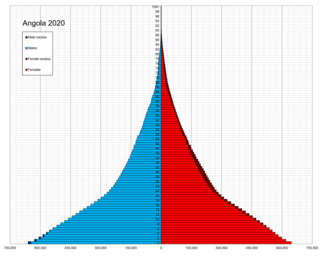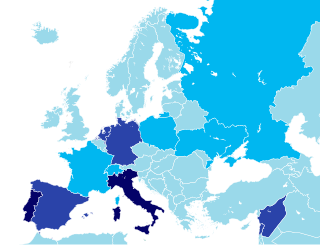Related Research Articles

Angola, officially the Republic of Angola, is a country on the west-central coast of Southern Africa. It is the second-largest Lusophone (Portuguese-speaking) country in both total area and population, and is the seventh-largest country in Africa. It is bordered by Namibia to the south, the Democratic Republic of the Congo to the north, Zambia to the east, and the Atlantic Ocean to the west. Angola has an exclave province, the province of Cabinda, that borders the Republic of the Congo and the Democratic Republic of the Congo. The capital and most populous city is Luanda.

Demographic features of the population of Angola include population density, ethnicity, education level, health of the populace, economic status, religious affiliations and other aspects.


Porto Alegre is the capital and largest city of the Brazilian state of Rio Grande do Sul. Its population of 1,488,252 inhabitants (2020) makes it the 12th-most populous city in the country and the center of Brazil's fifth-largest metropolitan area, with 4,405,760 inhabitants (2010). The city is the southernmost capital city of a Brazilian state.

The Brazil socio-geographic division is a slightly different division than the Brazilian Division by Regions. It separates the country into three different and distinctive regions:

The South Region of Brazil is one of the five regions of Brazil. It includes the states of Paraná, Rio Grande do Sul, and Santa Catarina, and covers 576,409.6 square kilometres (222,553.0 sq mi), being the smallest region of the country, occupying only about 6.76% of the territory of Brazil. Its whole area is smaller than that of the state of Minas Gerais, in Southeast Brazil, for example or the whole metropolitan France.

Immigration to Brazil is the movement to Brazil of foreign peoples to reside permanently. It should not be confused with the forcible bringing of people from Africa as slaves. Latin Europe accounted for four-fifths of the arrivals. This engendered a strikingly multicultural society. Yet over a few generations, Brazil absorbed these new populations in a manner that resembles the experience of the rest of the New World.

The Italian diaspora is the large-scale emigration of Italians from Italy. There were two major Italian diasporas in Italian history. The first diaspora began around 1880, two decades after the Unification of Italy, and ended in the 1920s to the early 1940s with the rise of Fascist Italy. Poverty was the main reason for emigration, specifically the lack of land as mezzadria sharecropping flourished in Italy, especially in the South, and property became subdivided over generations. Especially in Southern Italy, conditions were harsh. From the 1860s to the 1950s, Italy was still a largely rural society with many small towns and cities having almost no modern industry and in which land management practices, especially in the South and the Northeast, did not easily convince farmers to stay on the land and to work the soil.

The Dutch diaspora consists of the Dutch and their descendants living outside the Netherlands.
Brazilians in the United Kingdom or Brazilian Britons including Brazilian-born immigrants to the UK and their British-born descendants form the single largest Latin American group in the country.

As of 2021, Portugal had 1,198,793 inhabitants that were born in a foreign country, out of 10,467,366 inhabitants, accounting for 11.5% of its total population.
White Africans of European ancestry or Euro-Africans refers to people in Africa who can trace full or partial ancestry to Europe. In 1989, there were an estimated 4.6 million white people with European ancestry on the African continent.
Portuguese Australians refers to Australians of Portuguese descent or Portuguese-born people living in Australia.
Telecommunications in Angola include telephone, radio, television, and the Internet. The government controls all broadcast media with a nationwide reach.

Brazil had an official resident population of 203 million in 2022, according to IBGE. Brazil is the seventh most populous country in the world, and the second most populous in the Americas and Western Hemisphere.

Emigration from the United States is the process where citizens from the United States move to live in other countries, creating an American diaspora. The process is the reverse of the immigration to the United States. The United States does not keep track of emigration, and counts of Americans abroad are thus only available based on statistics kept by the destination countries.
Expatriates in the United Arab Emirates represent about 90% of the population, while Emiratis constitute roughly 12% of the total population, making the UAE home to one of the world's highest percentage of expatriates.

Immigration to Uruguay began in several millennia BCE with the arrival of different populations from Asia to the Americas through Beringia, according to the most accepted theories, and were slowly populating the Americas. The most recent waves of immigrants started with the arrival of Spaniards in the 16th century, during the colonial period, to what was then known as the Banda Oriental. Immigration to Uruguay is very similar to, if not the same, as immigration to Argentina.
There is a small but recognizable community of Angolans in Brazil consisting mainly of immigrants and expatriates from Angola. There are an estimated 17,294 Angolan citizens registered in Brazil, most Angolan citizens in the country are on student or work visas.

This article provides details regarding the geographical distribution of all Portuguese-speakers, a.k.a.Lusophones, regardless of legislative status. The Portuguese language is one of the most widely spoken languages in the world and is an official language of countries on four continents.
References
- ↑ Angola, Brasil
- ↑ "mixedindifferentshades.net". www.mixedindifferentshades.net. Archived from the original on 2016-12-29. Retrieved 2017-07-21.
- ↑ "Inter Press Service | News and Views from the Global South". ipsnews.net. Archived from the original on 2008-09-04. Retrieved 2017-07-21.
